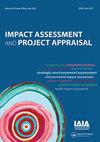A framework of stakeholder analysis for public participation in EIA process: a case study of Thailand
IF 1.9
4区 社会学
Q3 ENVIRONMENTAL STUDIES
引用次数: 0
Abstract
ABSTRACTThis study aims to 1) investigate current stakeholder analysis in Thai Environmental Impact Assessment (EIA) reports, 2) explore the opinions of key informants regarding the elements of stakeholder analysis relevant to Thai EIA, and 3) develop a framework of stakeholder analysis for public participation (PP) in the Thai EIA process. Qualitative methods were employed by reviewing 18 EIA reports, interviewing 36 key informants, and brainstorming in a workshop to develop a framework. The proposed framework of stakeholder analysis includes five domains: 1) context exploration, 2) stakeholder identification, 3) stakeholder categorisation, 4) determination of participation level, and 5) participatory technique selection. The finding suggested that key elements considered in the domains should include the identification of vulnerable groups, the characterisation of stakeholders, getting multiple groups of people involved in determining participation level, and assigning professional facilitator(s) in PP. This study recommends applying conflict resolution strategies e.g. generating informal contact with potential mainstays before public consultation, involving key stakeholders in an advisory committee, and using a local academic mediator.KEYWORDS: Stakeholderstakeholder analysisstakeholder identificationstakeholder categorisationdetermination of participation levelparticipatory technique selection AcknowledgmentsThe authors thank all reviewers for their constructive, critical and insightful comments, which were very helpful in improving this manuscript. We thank Smit Chiramongkol for his support during data collection and Dr Alan Marshall for proofreading the article.Disclosure statementNo potential conflict of interest was reported by the authors.Data availability statementData sharing is not applicable to this article as no new data were created or analysed in this study.Additional informationFundingThis work (Grant No. RGNS 63-172) was supported by Office of the Permanent Secretary, Ministry of Higher Education, Science, Research and Innovation (OPS MHESI), Thailand Science Research and Innovation (TSRI) and Mahidol University.公众参与环评过程的利益相关者分析框架——以泰国为例
摘要本研究旨在1)调查目前泰国环境影响评估(EIA)报告中的利益相关者分析;2)探讨关键举报人对泰国环境影响评估相关利益相关者分析要素的意见;3)为公众参与(PP)制定泰国环境影响评估过程中的利益相关者分析框架。采用定性方法,回顾了18份环评报告,采访了36名关键线人,并在研讨会上集思广益,制定了框架。提出的利益相关者分析框架包括五个领域:1)语境探索,2)利益相关者识别,3)利益相关者分类,4)参与水平确定,5)参与技术选择。研究结果表明,在这些领域中考虑的关键因素应包括弱势群体的识别、利益相关者的特征、让多个群体参与确定参与水平,以及在PP中指派专业调解人。本研究建议应用冲突解决策略,例如,在公众咨询之前与潜在支柱进行非正式接触,让关键利益相关者参与咨询委员会,并使用当地的学术调解人。关键词:利益相关者利益相关者分析利益相关者识别利益相关者分类参与水平确定参与技术选择感谢作者感谢所有审稿人建设性的、批判性的和有见地的意见,这些意见对本文的改进非常有帮助。我们感谢Smit Chiramongkol在数据收集过程中的支持,并感谢Alan Marshall博士对本文的校对。披露声明作者未报告潜在的利益冲突。数据可用性声明数据共享不适用于本文,因为本研究没有创建或分析新的数据。本研究经费(批准号:RGNS 63-172)得到了高等教育、科学、研究和创新部(OPS MHESI)、泰国科学研究和创新(TSRI)和玛希隆大学常任秘书长办公室的支持。
本文章由计算机程序翻译,如有差异,请以英文原文为准。
求助全文
约1分钟内获得全文
求助全文
来源期刊

Impact Assessment and Project Appraisal
ENVIRONMENTAL STUDIES-
CiteScore
4.60
自引率
22.70%
发文量
52
期刊介绍:
This is the international, peer-reviewed journal of the International Association for Impact Assessment (IAIA). It covers environmental, social, health and other impact assessments, cost-benefit analysis, technology assessment, and other approaches to anticipating and managing impacts. It has readers in universities, government and public agencies, consultancies, NGOs and elsewhere in over 100 countries. It has editorials, main articles, book reviews, and a professional practice section.
 求助内容:
求助内容: 应助结果提醒方式:
应助结果提醒方式:


